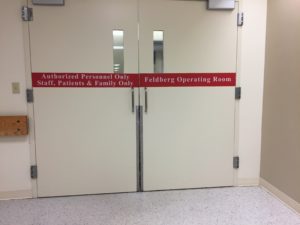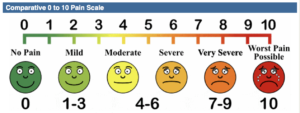TKR – Total Knee Replacement
By Nancy Upper
At 1:30 p.m. on Valentine’s Day, 2018, I drove my husband Dennis to Beth Israel Deaconess Medical Center in Boston for a total knee replacement, right knee. In the first-floor pre-op waiting room, we sat together reading, talking, and watching the wall monitor that displayed patient numbers and each patient’s status — checked in, in surgery, in PACU (post-anesthesia care unit), in recovery room.
Anticipation made tedium tolerable as our wait extended to an hour, then an hour and twenty-five minutes. The ennui vanished in a rush of adrenaline when we heard, “Dennis Upper.”
“Just him,” the waiting room attendant said when we both stood up. “You stay here with the pager. When it goes off, I’ll take you up to see him.”
An active, athletic kid, Dennis took up running in the 1960s. At a summer party in the early 70s, a backyard touch football game twisted his right knee, but he shrugged off the injury as minor and kept running. In 1980, he set his sights on the Boston Marathon. For a year, he logged more miles every week and ran the 1981 Marathon in three-and-a-half hours.
The race took a toll on his legs, especially his tweaked right knee. But he kept running. Later in the 80s, SCUBA (self-contained underwater breathing apparatus) intrigued him. He earned NAUI (National Association of Underwater Instructors) and PADI (Professional Association of Diving Instructors) certifications and dove in New England, Florida, and Bermuda.
In the 1990s, he intensified his tennis. In the early 2000s, tennis gave way to golf. In conversation he would say, “I used to be a runner.”
One evening in the early 2000s, on our way to the theatre in Boston, Dennis tripped over a curb and slammed his right knee on the concrete sidewalk. In 2010, sharp pain in the knee sent him to the orthopedist. Diagnosis: a “bone mouse” — a piece of chipped-off bone that had been wandering in his knee caught in the knee joint. A few years later, another bone mouse.
By 2015, Dennis’s right knee noticeably bowed out. His walking distances shortened, and he walked with a limp. By 2016, he was going down stairs one at a time, right leg leading.
He soldiered through my August 2017 total left hip replacement, providing the best recuperative care anyone would wish for, rarely revealing to me his knee pain. He prides him on being stoic.
Uhnnn, uhnnn, uhnnn, uhnnn — my beeper went off. The attendant walked me to the elevator. On the fifth floor, she introduced me to the anesthesia nurse, who led me between beige double doors to Dennis.
He was lying on a gurney surrounded by white curtains with an IV in his arm and tubes attached to the backs of his hands for injecting medicines. The anesthesiologist introduced himself and his team. The same brilliant orthopedic surgeon who had replaced my left hip, Dr. Douglas K. Ayres, came to Dennis’s bedside. Dr. Ayres described the artificial joint he was going to implant in Dennis’s right leg. He said, “You are going to be very happy with this. Your leg will be nice and straight again.”
I looked at the wall clock. Its hands said 4:35 p.m.
The anesthesia nurse led me out, and the beige double doors closed behind me. I turned around to look at them. A red stripe spanned both doors. The white letters in the red stripe spelled —
Staff, Patients & Family Only
Feldberg Operating Room
The ampersand holds Patients & Family together after the doors close behind Family, leaving Patients in the hands of Authorized Personnel.
The ampersand held me close to Dennis as I drove home, trusting that the surgeon would do superb work. Positive expectations create positive outcomes.
Dr. Ayres called me that evening at 7:30. He said the surgery went perfectly. “It was a complete success. Dennis has a strong, straight leg now.” I fell asleep dreaming of that ampersand uniting us.
That same night in his hospital room, Dennis suffered agony.
When I visited him in the morning, he said he had hoped to get through recovery without taking pain drugs. As the surgical numbing medicines wore off, by 11:00 p.m. he felt deep, piercing knee pain so intense it throbbed through every nerve in his body. With a shaking hand he rang for the nurse. She gave him two Oxycodone pills and injected morphine. These powerful pain-killers brought no relief. Dennis had waited so long to ask for help, the pain stampeded through him faster than the medicines could act. Over the next four hours, another morphine shot, an injection of mega-strength Tylenol, and 2 more Oxycodones finally ended his anguish. So much for trying to be stoic.
“Stay ahead of the pain,” said the nurse. “Take the meds when you think you’re going to need them, before discomfort sets in.” In other words, listen to your body, not your bold decisions.
An ingenious surgical implant put Dennis ahead of the recovery game. The surgeon said that Dennis’s femur had been so severely dislodged off the tibia, the distance between the two bones was wider than normal. During surgery, he inserted a four-millimeter pad with grooves in it to allow the femur to nestle securely into the lower leg. He said, “This pad makes the knee very stable.”
After a two-day hospital stay, Dennis made a rapid recovery. Patience & family pulled him through.
I think of the “shim” in Dennis’s knee as an ampersand that connects his thigh to his calf, his head to his feet, his thoughts to his walk, his stride to his confidence. The TKR rejuvenated him. The extra connector in his knee adds secret vitality.

